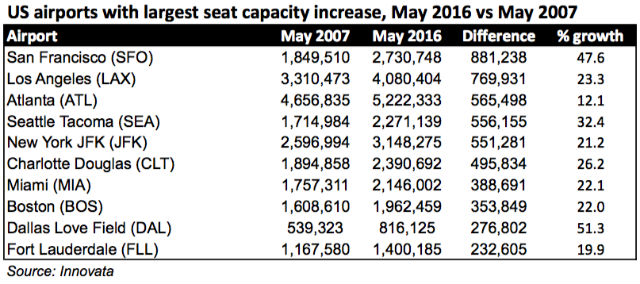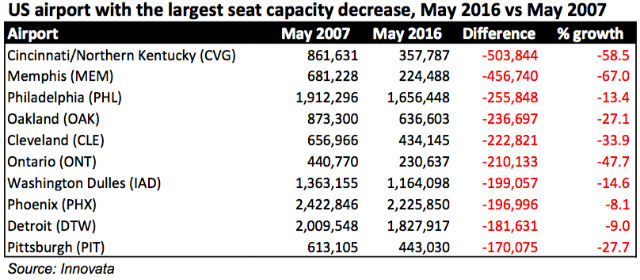Passenger traffic dropped during the 2008 credit crunch, prompting US airlines to cut capacity across the board. No airport, big or small, was spared.
Capacity has climbed with demand during the past eight years, with passenger traffic surpassing its 2007 peak of 838 million by notching 848 million passengers in 2014, US Department of Transportation data shows.
That rising passenger tide, however, has not lifted all airports.
Airlines will fly more seats at only about 40% of airports across the USA in May than they did the same month in 2007 – before the recession hit – Innovata data shows.
Some of the largest gains were seen at San Francisco International and Los Angeles International airports, two booming hubs and with intense competition, while many of the other airports with gains were large or medium-sized and serving major metropolitan areas.

The airports that remain way down from their May 2007 numbers are, as expected, ones that have lost airlines hubs, like Cleveland and Memphis, but also include major hubs like Philadelphia that have been impacted by shifts in the US industry.

DISCIPLINED BOOM
Moody’s Investors Service attributes the concentrated growth of large US airports to industry capacity discipline and the shift to fewer, larger regional aircraft, in its 2016 US airport outlook.
“Small airports are, in a majority of cases, highly concentrated in legacy carriers American Airlines, Delta Air Lines and United Airlines and those airlines have been constraining capacity,” the rating agency says. “Additionally, Southwest Airlines has been reallocating air service to large and medium hub airports, while faster growing JetBlue and Spirit Airlines concentrate on large and medium hubs.”
All 10 of the airports that have seen the most capacity growth in the nine years since May 2007 are large, sought-after hubs, with the exception of Dallas Love Field.
The fastest growing, San Francisco, has been buoyed by the technology boom in nearby Silicon Valley and the growth of Virgin America, which began flying with a base at the airport in 2007.
In addition, JetBlue and Southwest, both of which flew to other nearby airports, launched service to San Francisco that year.
Scott Laurence, senior vice-president of New York-based JetBlue, said in 2014 the airline can earn a higher unit revenue premium at large hub airports like San Francisco than it can from secondary airports, like nearby Oakland or San Jose.
San Francisco is also a growth centre for international carriers. Air Berlin, Air India, China Southern Airlines, Copa Airlines, Etihad Airways and Turkish Airlines have all added service to the airport while others, like British Airways, have increased capacity in the past two years, Innovata FlightMaps Analytics shows.
Dallas Love Field is a unique case. Capacity jumped at the airport following the removal of the Wright Amendment, which limited nonstop flights to within Texas, bordering states and to Alabama, Kansas, Mississippi and Missouri, in October 2014. Southwest immediately jumped on the opportunity, increasing its schedule to 180 daily flights by August, from 118.
In addition, Virgin America opened a focus city at the Dallas airport that October and now operates 20 daily flights to five cities.
"It's been a raging success and it has a 20-gate cap," said Gary Kelly, chief executive of Southwest, on the growth at Love Field in April 2015. "It's very clear that the demand is much greater than 20 gates."
In January, Southwest chief financial officer Tammy Romo said Dallas Love Field continued to “outperform the system on margins and return”.
MARKET SHIFT
The airports that have lost the most capacity since 2007 tell multiple stories. There are the former hubs – Cincinnati/Northern Kentucky, Cleveland, Memphis and Pittsburgh – and ones in multi-airport regions – Oakland, Ontario and Washington Dulles – that have seen traffic shift to other nearby facilities.
Detroit, Philadelphia and Phoenix stand out as hubs that remain well below pre-recession capacity.
The merger of Delta Air Lines and Northwest Airlines in 2009 is probably the driver of the capacity drop at Detroit Metropolitan Wayne County airport. Traffic decreased about 9% that year and has held steady since, said Fitch Ratings in its latest review of the airport’s debt, published in December.
The rating agency does not expect significant further capacity cuts at the Michigan airport due to its geographic importance to Atlanta-based Delta’s network, especially as the carrier has shrunk its Cincinnati hub and has few nearby competitors for passengers.
Philadelphia International airport is a large hub for American, which it gained in its merger with US Airways in 2013. While the combined American and US Airways capacity is down just slightly at 4% in May compared to nine years ago, Southwest capacity is down nearly 74%, Capstats data shows.
Southwest was in the midst of building a focus city at the airport in 2007 but pulled down almost the entire operation to just 21 flights in 2012, says Fitch. The cuts are even greater when seats flown by AirTran Airways, which Southwest absorbed from 2010 to 2015, are included.
Phoenix Sky Harbor International airport is also a large hub for American by way of the US Airways merger, and a large base for Southwest. Both airlines have shrunk seat capacity there, by 5% and nearly 26%, respectively, while maintaining large connecting operations, Capstats shows.
Beyond these 10 airports is a long list of small and medium-sized US airports that remain below pre-recession capacity.
For example, airlines will fly nearly 40% fewer seats into Reno-Tahoe International airport in May than they did in the same month nine years ago, Innovata shows. This comes despite strong local economic data and major recent investments, including Tesla’s plans to build a $5 billion battery factory.
Fitch attributes the capacity drop primarily to Southwest’s market dominance. The Dallas-based carrier has cut capacity as it has shifted towards serving more larger markets over its former bread-and-butter small and medium-sized ones – including Reno. It carries about 50% of the traffic from the northern Nevada airport.
Capacity discipline at the US mainline carriers has also allowed them to focus growth in the largest markets, like Los Angeles and New York, while growing little at airports like Reno across the country, Moody’s notes in its 2016 outlook.
Reno is seeing some gains. JetBlue will begin new service to Long Beach in August and Alaska began Orange County flights in March. Southwest will also resume flights to Oakland in June after a three-year hiatus.
Source: Cirium Dashboard























